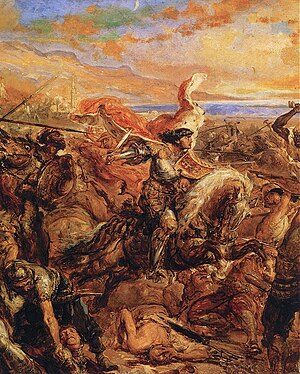Battle of Varna
| Battle of Varna | |||||||
|---|---|---|---|---|---|---|---|
| Part of the Crusade of Varna and the Ottoman wars in Europe | |||||||
 Władysław III of Poland leading the cavalry charge, by Jan Matejko |
|||||||
|
|||||||
| Belligerents | |||||||
|
|
|
||||||
| Commanders and leaders | |||||||
|
|
|
||||||
| Strength | |||||||
| 20,000 / 24,000 (15,000 Polish, Hungarian, Croatian, Bohemian soldiers, 7,000 – 8,000 Wallachians, 1,000 soldiers from Lithuania, Papal States, Holy Roman Empire, Croatia, Bulgaria) | 20,000 -24.000-60,000 (15,000 regular Janissary, Sipahi, Mercenary of the Sultan) |
||||||
| Casualties and losses | |||||||
| 20.000 30,000 | 15.000 | ||||||
The Battle of Varna took place on 10 November 1444 near Varna in eastern Bulgaria. The Ottoman Army under Sultan Murad II defeated the Hungarian-Polish and Wallachian armies commanded by Władysław III of Poland (also King of Hungary), John Hunyadi (acting as commander of the combined Christian forces) and Mircea II of Wallachia. It was the final battle of the Crusade of Varna.
The Hungarian Kingdom fell into crisis after the death of King Sigismund in 1437. His son-in-law and successor, King Albert, ruled for only two years and died in 1439, leaving his widow Elizabeth with an unborn child, Ladislaus the Posthumous. The Hungarian noblemen then called the young King Władysław III of Poland to the throne of Hungary, expecting his aid in defense against the Ottomans. After his Hungarian coronation, he never went back to his homeland again, assuming rule of the Hungarian Kingdom next to the influential nobleman John Hunyadi.
After failed expeditions in 1440–42 against Belgrade and Transylvania, and the defeats of the "long campaign" of Hunyadi in 1442–43, the Ottoman sultan Murad II signed a ten-year truce with Hungary. After he had made peace with the Karaman Emirate in Anatolia in August 1444, he resigned the throne to his twelve-year-old son Mehmed II.
...
Wikipedia
